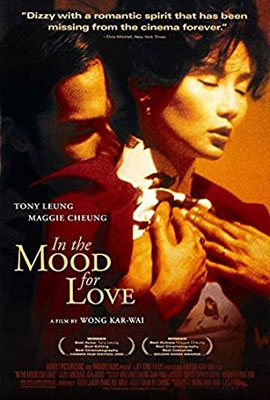
(2000)
directed by Wong Kar-Wai
“In the Mood for Love” is the most beautiful film I have ever seen. Wong Kar-Wai’s film is a love story about falling in love. With lush visuals, precise framing, and dreamlike slow motion, Wong’s film is both sensual and emotionally devastating. “In the Mood for Love” is about falling in love but it is also about loneliness, betrayal, and memory.
Wong’s film is a story about two lonely people in the crowded city of Hong Kong in 1962. Mr. Chow (Tony Leung) and Mrs. Su (Maggie Cheung) are next door neighbors in the same apartment building. Both of their spouses work late and travel frequently. Mr. Chow and Mrs. Su often pass by each other on their way to the noodle shop below their apartments.
Mr. Chow and Mrs. Su both believe their spouses are having an affair. After sharing a meal together, however, they suddenly realize that their spouses are having an affair with each other. Mr. Chow and Mrs. Su start spending time together. Their friendship has a quiet dignity. “For us to do the same thing,” they agree, “would mean we are no better than they are.” Eventually, they develop feelings for each other and fall in love. Wong famously filmed the couple in a love scene. In a stroke of genius, however, he decided not to use it in the film. The couple are eternally in a state of falling in love and “In the Mood for Love” remains true to its title.
The most extraordinary scenes in the film are when Chow and Su role play imaginary scenes with their cheating spouses. “Do you have a mistress?” she asks, and we think she is asking Chow, but she is actually asking her husband, whose role is being played by Chow. “I didn’t expect it to hurt so much,” Su says, after one of their imaginary scenarios.
Tony Leung, who won the Best Actor prize at Cannes, and Maggie Cheung, who took home a Taiwanese Oscar, give glamorous performances of breathtaking beauty. They are among the most gorgeous couples in movie history. She wears figure hugging silk dresses. He wears elegant suits with a selection of beautiful ties. Every detail is sensual, the click of high heels, the whisper of silk, street lights reflected on rainy city streets.
Rich, lush colors convey the mystery of falling in love. Deep dark reds, golden yellows, and shadowy blacks saturate the film. The beautiful reds and blacks express the intensity of repressed love. The camera moves along rainy city streets, up staircases, and across the hallways that separate apartments.
Wong uses music to devastating emotional effect. Nat King Cole songs play throughout the film. The instrumental “Green Eyes,” suggesting jealousy, is playing at the moment they realize their spouses are having an affair. Cole’s singing is haunting when he croons Quizas, quizas, quizas. (“Perhaps, perhaps, perhaps.”)
The last part of “In the Mood for Love” tells of missed opportunities. Mr. Chow moves to Singapore. When Su travels to Singapore to see Chow, she waits in his apartment but departs without seeing him, leaving behind only a lipstick-stained cigarette. When Chow visits his former apartment building, he learns that a young woman and her son have recently moved in. He leaves without realizing that it’s actually Su and her son.
At the end of the film, Mr. Chow whispers his pain and regrets into a stone hollow at Cambodia’s Angkor Wat temple complex. “In the Mood for Love” is a sublimely beautiful film that captures the loneliness of unfulfilled desire with exquisite tenderness.